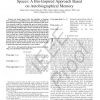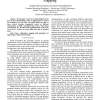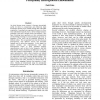271 search results - page 1 / 55 » Bio-inspired Model of Robot Adaptive Learning and Mapping |
TSMC
2010
12 years 11 months ago
2010
In Smart Spaces (SSs), the capability of learning from experience is fundamental for autonomous adaptation to environmental changes and for proactive interaction with users. New re...
IROS
2006
IEEE
13 years 10 months ago
2006
IEEE
- In this paper we present a model designed on the basis of the neurophysiology of the rat hippocampus to control the navigation of a real robot. The model allows the robot to lear...
ASC
2004
13 years 4 months ago
2004
In this paper, we describe development of a mobile robot which does unsupervised learning for recognizing an environment from action sequences. We call this novel recognition appr...
ISCAS
2006
IEEE
13 years 10 months ago
2006
IEEE
— In many application areas, robots most suitably employ classical PID controllers and the like. In the field of autonomous mobile robots, however, further adaptation features a...
FLAIRS
2009
13 years 2 months ago
2009
As robots become more common, it becomes increasingly useful for them to communicate and effectively share knowledge that they have learned through their individual experiences. L...



